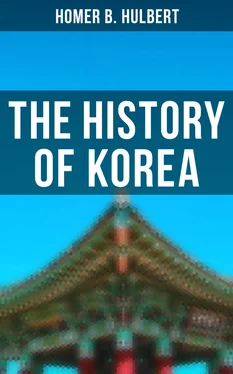Swords, arrows and spears were their common weapons. A widow usually became the wife of her dead husband’s brother. When a great man died it was common to bury one or more men alive with his body. The statement that sometimes as many as a hundred were killed is probably an exaggeration. These characteristics were those of the Nang-nang people as well as of the rest of Ko-gu-ryŭ. The highest official grades were called Sang-ga-dă, No-p’ă, Ko-ju-dă. Some say their official grades were called by the names of animals, as the “horse grade” the “dog grade” the “cow grade.” There were special court garments of silk embroidered with gold and silver. The court hat was something like the present kwan or skull-cap. There were few prisoners. If a man committed a crime he was summarily tried and executed, and his wife and children became slaves. Thieves restored twelve-fold. Marriage always took place at the bride’s house. The dead were wrapped in silks and interred, and commonly the entire fortune of the deceased was exhaustedin the funeral ceremony. The bodies of criminals were left unburied. The people were fierce and violent and thieving was common. They rapidly corrupted the simpler and cleaner people of the Ye-măk and Ok-jŭ tribes.
No sooner had Chu-mong become firmly established in his new capital than he began to extend the limits of his kingdom. In 35 B.C. he began a series of conquests which resulted in the establishment of a kingdom destined to defy the power of China for three quarters of a millennium. His first operations were against the wild people to the east of him. The first year he took Pu-ryu on the Ya-lu, then in 29 B.C. he took Hăng-in, a district near the present Myo-hyang San. In 27 B.C. he took Ok-jŭ, thus extending his kingdom to the shore of eastern Korea. In 23 B.C. he learned that his mother had died in far off Pu-yŭ and he sent an embassy thither to do honor to her.
The year 18 B.C. beheld the founding of the third of the great kingdoms which held the triple sceptre of Korea, and we must therefore turn southward and examine the events which led up to the founding of the kingdom of Păk-je.
When Chu-mong fled southward from Pu-yŭ he left behind him a wife and son. The latter was named Yu-ri. Tradition says that one day while playing with pebbles in the street he accidentally broke a woman’s water jar. In anger she exclaimed “You are a child without a father.” The boy went sadly home and askedhis mother if it was true. She answered yes, in order to see what the boy would do. He went out and found a knife and was on the point of plunging it into his body when she threw herself upon him saying “Your father is living and is a great king in the south. Before he left he hid a token under a tree, which you are to find and take to him.” The boy searched every where but could not find the tree. At last, wearied out, he sat down behind the house in despair, when suddenly he heard a sound as of picking, and noticing that it came from one of the posts of the house he said “This is the tree and I shall now find the token.” Digging beneath the post he unearthed the broken blade of a sword. With this he started south and when he reached his father’s palace he showed the token. His father produced the other half of the broken blade and as the two matched he received the boy and proclaimed him heir to the throne.
But he had two other sons by a wife whom he had taken more recently. They were Pi-ryu and On-jo. When Yu-ri appeared on the scene these two brothers, knowing how proverbially unsafe the head of a king’s relative is, feared for their lives and so fled southward. Ascending Sam-gak San, the mountain immediately behind the present Seoul, they surveyed the country southward. Pi-ryu the elder chose the country to the westward along the sea. On-jo chose to go directly south. So they separated, Pi-ryu going to Mi-ch’u-hol, now In-ch’ŭn near Chemulpo, where he made a settlement. On-jo struck southward into what is now Ch’ung-ch’ŭng Province and settled at a place called Eui-rye-sŭng, now the district of Chik-san. There he was given a generous tract of land by the king of Ma-han; and he forthwith set up a little kingdom which he named South Pu-yŭ. The origin of the name Păk-je is not definitely known. Some say it was because a hundred men constituted the whole of On-jo’s party. Others say that it was at first called Sip-je and then changed to Păk-je when their numbers were swelled by the arrival of Pi-ryu and his party. The latter had found the land sterile and the climate unhealthy at Mi-ch’u-hol and so was constrained to join his brother again. On the other hand we find the name Păk-je in the list of original districts of Ma-han and it is probable that this new kingdom sprang up in the district called Păk-je and this name became so connected with it that it has came down in history as Păk-je, while in truth it was not called so by its own people. It the same way Cho-sŭn is known today by the medieval name Korea. Not long after Pi-ryu rejoined his brother he died of chagrin at his own failure.
It must not be imagined that these three kingdoms of Sil-la, Ko-gu-ryŭ and Păk-je, which represented so strongly the centripetal idea in government, were allowed to proceed without vigorous protests from the less civilized tribes about them. The Mal-gal tribes in the north, the Suk-sin and North Ok-jŭ tribe in the north-east and Ye-măk in the east made fierce attacks upon them as opportunity presented. The Mal-gal tribes in particular seem to have penetrated southward even to the borders of Păk-je, probably after skirting the eastern borders of Ko-gu-ryŭ. Nominally Ko-gu-ryŭ held sway even to the Japan Sea but practically the wild tribes roamed as yet at will all through the eastern part of the peninsula. In the eighth year of On-jo’s reign, 10 B.C., the Mal-gal forces besieged his capital and it was only after a most desperate fight that they were driven back. On-jo found it necessary to build the fortresses of Ma-su-sŭng and Ch’il-chung-sŭng to guard against such inroads. At the same time the Sŭn-bi were threatening Ko-gu-ryŭ on the north, but Gen. Pu Bun-no lured them into an ambush and routed them completely. The king rewarded him with land, horses and thirty pounds of gold, but the last he refused.
The next year the wild men pulled down the fortresses lately erected by King On-jo and the latter decided that he must find a better site for his capital. So he moved it to the present site of Nam-han, about twenty miles from the present Seoul. At the same time he sent and informed the king of Ma-han that he had found it necessary to move. The following year he enclosed the town in a wall and set to work teaching agriculture to the people throughout the valley of the Han River which flowed near by.
In the year which saw the birth of Christ the situation of affairs in Korea was as follows. In the north, Ko-gu-ryŭ, a vigorous, warlike kingdom, was making herself thoroughly feared by her neighbors; in the central western portion was the little kingdom of Păk-je, as yet without any claims to independence but waiting patiently for the power of Ma-han so to decline as to make it possible to play the serpent in the bosom as Wi-man had done to Ki-ja’s kingdom. In the south was Sil-la, known as a peaceful power, not needing the sword because her rule was so mild and just that people from far and near flocked to her borders and craved to become her citizens. It is one of the compensations of history that Sil-la, the least martial of them all, in an age when force seemed the only arbiter, should have finally overcome them all and imposed upon them her laws and her language.
Change of Ko-gu-ryu capital. … Sil-la raided. … Legend of Suk-ta’l-ba … fall of Ma-han … beginning of Chinese enmity against Ko-gu-ryu … the three kingdoms differentiated. … King Yu-ri degraded … extension of Ko-gu-ryu. … Japanese corsairs … remnant of Ma-han revolts … fall of Pu-yu … origin of in-gum … siege of Ko-gu-ryu capital raised. … Sil-la’s peaceful policy … patronymics … official grades … unoccupied territory … kingdom of Ka-rak … legends … position … dependencies.
Читать дальше









